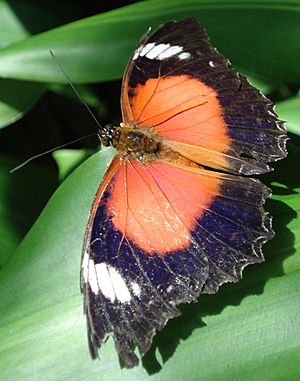Eastern red lacewing facts for kids
Quick facts for kids Eastern red lacewing |
|
|---|---|
 |
|
| Cethosia cydippe chrysippe | |
| Scientific classification | |
| Genus: |
Cethosia
|
| Species: |
cydippe
|
| Subspecies | |
|
See text |
|
| Synonyms | |
|
|
The eastern red lacewing (scientific name: Cethosia cydippe) is a beautiful species of butterfly. You can find it in places like Australia, New Guinea, and the islands nearby. In Australia, a special type of this butterfly, called C. c. chrysippe, is simply known as the red lacewing.
Contents
What Does It Look Like?
The adult butterflies, also called imagines, have bright scarlet (red) wings. These wings have thick black edges. They also have a white patch that goes across the front wings.
If you look at the underside of their wings, it's orange. It has similar white patches and lines of black spots. Each black spot has a white outline around it. These butterflies have a wingspan of about 8 centimeters (about 3 inches).
Life Story and Where It Lives
The eastern red lacewing butterfly starts its life as a tiny egg. The female butterfly lays pale yellow eggs in groups. She can lay about 50 eggs at one time! She places them on specific plants.
When the eggs hatch, tiny caterpillars come out. These caterpillars are herbivorous, meaning they only eat plants. They love to munch on vines from the Passifloraceae family. This includes plants like Adenia heterophylla, also known as lacewing vine. They also eat Hollrungia aurantioides, which is a type of Queensland passion-fruit.
The caterpillars are black with bright yellow bands. They also have long black hairs. These caterpillars often gather together in groups on their food plants.
After growing big enough, the caterpillar changes into a pupa. The pupae are brown and have spiky bits. They also have black and gold markings. They hang upside down from a small hook called a cremaster. They look a lot like a dead leaf, which helps them hide from predators.
How Scientists Name and Group Them
Scientists use a system called taxonomy to name and group all living things. The eastern red lacewing was first described by a famous scientist named Carl Linnaeus. He named it Papilio cydippe in 1767.
Linnaeus thought this butterfly came from India. However, scientists later realized he was actually talking about Indonesia. So, the place where the first example of this butterfly was found is now considered to be Ambon Island.
There are many different types, or "subspecies," of the eastern red lacewing. Two well-known ones are C. c. cydippe and C. c. chrysippe.
- C. c. cydippe lives in places like the Aru Islands, the Kai Islands, and Maluku in Indonesia. You can also find it in New Guinea, both in Irian Jaya and Papua New Guinea.
- C. c. chrysippe was first described in 1775. This subspecies is special because it only lives in Queensland, Australia. You can find it in the northern Gulf Country and along the north-east coast.
See also
 In Spanish: Cethosia cydippe para niños
In Spanish: Cethosia cydippe para niños

